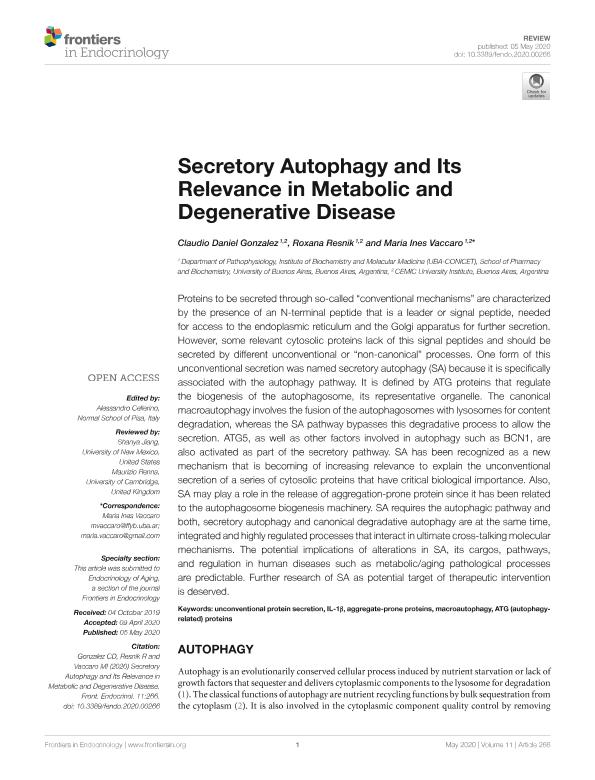Mostrar el registro sencillo del ítem
dc.contributor.author
González, Claudio Daniel

dc.contributor.author
Resnik, Roxana
dc.contributor.author
Vaccaro, Maria Ines

dc.date.available
2021-08-31T16:04:16Z
dc.date.issued
2020-05
dc.identifier.citation
González, Claudio Daniel; Resnik, Roxana; Vaccaro, Maria Ines; Secretory Autophagy and Its Relevance in Metabolic and Degenerative Disease; Frontiers Media S.A.; Frontiers in Endocrinology; 11; 5-2020; 110-112
dc.identifier.issn
1664-2392
dc.identifier.uri
http://hdl.handle.net/11336/139321
dc.description.abstract
Proteins to be secreted through so-called “conventional mechanisms” are characterized by the presence of an N-terminal peptide that is a leader or signal peptide, needed for access to the endoplasmic reticulum and the Golgi apparatus for further secretion. However, some relevant cytosolic proteins lack of this signal peptides and should be secreted by different unconventional or “non-canonical” processes. One form of this unconventional secretion was named secretory autophagy (SA) because it is specifically associated with the autophagy pathway. It is defined by ATG proteins that regulate the biogenesis of the autophagosome, its representative organelle. The canonical macroautophagy involves the fusion of the autophagosomes with lysosomes for content degradation, whereas the SA pathway bypasses this degradative process to allow the secretion. ATG5, as well as other factors involved in autophagy such as BCN1, are also activated as part of the secretory pathway. SA has been recognized as a new mechanism that is becoming of increasing relevance to explain the unconventional secretion of a series of cytosolic proteins that have critical biological importance. Also, SA may play a role in the release of aggregation-prone protein since it has been related to the autophagosome biogenesis machinery. SA requires the autophagic pathway and both, secretory autophagy and canonical degradative autophagy are at the same time, integrated and highly regulated processes that interact in ultimate cross-talking molecular mechanisms. The potential implications of alterations in SA, its cargos, pathways, and regulation in human diseases such as metabolic/aging pathological processes are predictable. Further research of SA as potential target of therapeutic intervention is deserved.
dc.format
application/pdf
dc.language.iso
eng
dc.publisher
Frontiers Media S.A.

dc.rights
info:eu-repo/semantics/openAccess
dc.rights.uri
https://creativecommons.org/licenses/by/2.5/ar/
dc.subject
AGGREGATE-PRONE PROTEINS
dc.subject
ATG (AUTOPHAGY-RELATED) PROTEINS
dc.subject
IL-1Β
dc.subject
MACROAUTOPHAGY
dc.subject
UNCONVENTIONAL PROTEIN SECRETION
dc.subject.classification
Bioquímica y Biología Molecular

dc.subject.classification
Medicina Básica

dc.subject.classification
CIENCIAS MÉDICAS Y DE LA SALUD

dc.title
Secretory Autophagy and Its Relevance in Metabolic and Degenerative Disease
dc.type
info:eu-repo/semantics/article
dc.type
info:ar-repo/semantics/artículo
dc.type
info:eu-repo/semantics/publishedVersion
dc.date.updated
2021-08-25T19:43:56Z
dc.journal.volume
11
dc.journal.pagination
110-112
dc.journal.pais
Suiza

dc.description.fil
Fil: González, Claudio Daniel. Consejo Nacional de Investigaciones Científicas y Técnicas. Oficina de Coordinación Administrativa Parque Centenario. CEMIC-CONICET. Centro de Educaciones Médicas e Investigaciones Clínicas "Norberto Quirno". CEMIC-CONICET; Argentina. Consejo Nacional de Investigaciones Científicas y Técnicas. Oficina de Coordinación Administrativa Houssay. Instituto de Bioquímica y Medicina Molecular. Universidad de Buenos Aires. Facultad Medicina. Instituto de Bioquímica y Medicina Molecular; Argentina
dc.description.fil
Fil: Resnik, Roxana. Consejo Nacional de Investigaciones Científicas y Técnicas. Oficina de Coordinación Administrativa Houssay. Instituto de Bioquímica y Medicina Molecular. Universidad de Buenos Aires. Facultad Medicina. Instituto de Bioquímica y Medicina Molecular; Argentina. Consejo Nacional de Investigaciones Científicas y Técnicas. Oficina de Coordinación Administrativa Parque Centenario. CEMIC-CONICET. Centro de Educaciones Médicas e Investigaciones Clínicas "Norberto Quirno". CEMIC-CONICET; Argentina
dc.description.fil
Fil: Vaccaro, Maria Ines. Consejo Nacional de Investigaciones Científicas y Técnicas. Oficina de Coordinación Administrativa Houssay. Instituto de Bioquímica y Medicina Molecular. Universidad de Buenos Aires. Facultad Medicina. Instituto de Bioquímica y Medicina Molecular; Argentina. Consejo Nacional de Investigaciones Científicas y Técnicas. Oficina de Coordinación Administrativa Parque Centenario. CEMIC-CONICET. Centro de Educaciones Médicas e Investigaciones Clínicas "Norberto Quirno". CEMIC-CONICET; Argentina
dc.journal.title
Frontiers in Endocrinology
dc.relation.alternativeid
info:eu-repo/semantics/altIdentifier/url/https://www.frontiersin.org/article/10.3389/fendo.2020.00266/full
dc.relation.alternativeid
info:eu-repo/semantics/altIdentifier/doi/http://dx.doi.org/10.3389/fendo.2020.00266
Archivos asociados
